The 1st Okinawa Karate International Tournament Competition Rules and Regulations
Article 1: Competition Court
- The competition court must be a matted square or a wooden flat square with sides of 8 meters in length.
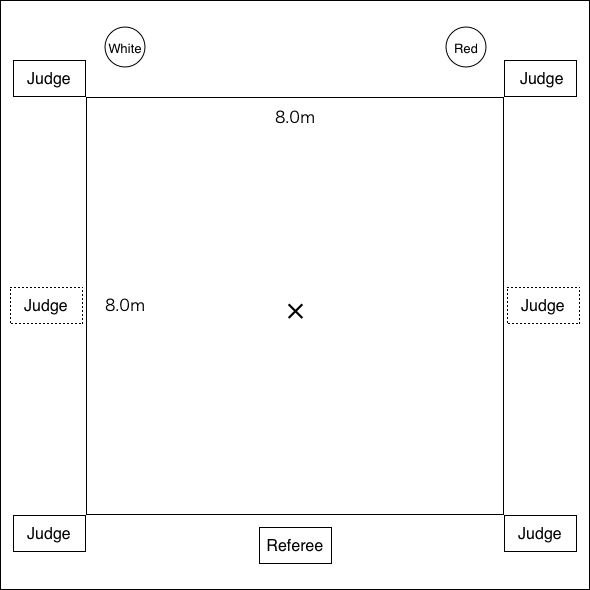
Article 2: Official Uniform
Competitors, coaches, referees, and judges must wear the official uniform as prescribed in each of the following items.
- Competitors must wear a plain white karate-gi, however kobudo competitors are also allowed to wear black or brown karate-gi. Hakama (divided skirt used in other martial arts) are not permitted.
- It is permitted to bear ryuha/kaiha emblems, country flags (excluding the prefectural emblem of Okinawa), and national emblems on only left chest of karate-gi. Any other letters, emblems, labels, etc. are not allowed on other parts. However, trademark labels of manufactures already processed on the karate-gi are allowed.
- A competitor number issued by The 1st Okinawa Karate International Tournament Executive Committee (hereinafter referred to as “Executive Committee”) must be put on the back.
- To wear any kind of shirts such as T-shirt under the karate-gi is prohibited. However in the case of women, only plain white T-shirt or same plain color as the jacket can be worn under the karate jacket.
- The jacket, when tightened around the waist with the belt, must be no longer than mid-thigh length.
- The maximum length of the jacket sleeves must be no longer than the bend of the wrist and no shorter than halfway down the forearm. Jacket sleeves may not be rolled up.
- The trousers must be long enough to cover at least two-thirds of the shin and may not be rolled up.
- Red belts and red-white belts are not acceptable (white belts are acceptable). In flag system competition, the competitors should tie the red or white string around the waist prepared by the Executive Committee to identify competitor.
- Hachimaki (headbands), hair clips and metallic hair pins are prohibited.
- The use of bandages or braces because of injuries must be approved by the Executive Committee with the diagnosis of the doctor.
- The coach shall, at all times during the tournament, wear a karate-gi and arm band on his/her left or right bicep.
- The referees shall wear a dark navy blue blazer jacket, gray trousers, and a white short-sleeve shirt, with black socks and indoor black shoes; and a tie designated by the Executive Committee.
Those who fail to comply with the regulations up to the preceding paragraph may be disqualified from entry qualifications.
Article3: Organization of the Competition
- The competition consists of four individual Kata performances separated by male and female in Juniors, Adults I, Adults II, and Seniors respectively.
- The competition will be carried out in five categories consisting of Shuri-te/Tomari-te, Naha-te, Uechi ryu, Kobudo (Bo), and Kobudo (Sai).
Article 4: The Referee Panel
- The panel of six judges (1 referee, 4 judges, and 1 auditor) or eight judges (1 referee, 6 judges, 1 auditor) for each match will be designated by the chairman of the Referee Council before the match.
- The chief referee may appoint several score-keepers, callers and announcers to facilitate the smooth operation of the competitions.
Article 5: Competition Procedure
- The competition shall be carried out by either a scoring system or a flag system (tournament).
- In the scoring system, each competitor performs Kata and the ranking is determined according to the score indicated by the referee panel.
- In the flag system, two red and white competitors perform Kata and the referee panel judges the win or loss.
- The preliminary rounds in Okinawa will be implemented as follows.
- The first round decides the ranking as the scoring system, and the high score competitors will advance to the second round.
- The second round will be conducted with the flag system. The winning competitors will advance to the main tournament.
- The ranking of the preliminary rounds in mainland Japan and overseas are to be decided according to the scoring system, and the high score competitors will advance to the main tournament.
- The main tournament will be held in the flag system.
Article 6: Scoring System
- In the scoring system, the scores and rankings of each competitor are determined according to the following items.
- The score of each competitor shall be the total of scores indicated by the referee and the judges, excluding the highest and lowest scores.
- In the event that plural competitors are aligned at the same score on the entry line of the next match advancement, the lowest point excluded in the previous issue is added to the score of the competitor and the rank is determined at the total point. Nevertheless, if several competitors are aligned at the same score, the highest points excluded in the previous issue shall be further added and the ranking shall be decided at the total point.
- In the previous issue, in case plural competitors still ranks at the same score, the competitors will perform play-off, and the ranking will be decided based on the rules up to the 2nd issue. In this case, it is not allowed to select the same Kata as the ones previously performed.
- Nevertheless, if more than one competitor still rank at the same score according to the method up to the previous issue, the ranking shall be decided by consultation of the referee panel.
- The procedures of the competition in the scoring system are as follows.
- The competitor stands at the boundary line of the competition court, bows to the front, and then advances to the starting position.
- Reaching the starting position, the competitor bows, then gives the name of Kata to be performed, and starts the performance. After the performance ends, the competitor bows, turns over and exits the court, stands at the boundary line of the court, then waits for judgment by the judges.
- The referee and the judges shall simultaneously show the scoring boards based on the whistle signal of the referee.
- After the caller announces the score and confirms that it was recorded, the referee and the judges raise down the scoring boards based on the whistle signal of the referee.
Article 7: Flag System
- In the flag system, red and white flags are used to judge victory or defeat.
- The procedures of the competition in the flag system are as follows.
- Both red and white competitors aligned at the boundary of the court, bow to the front, and after bowing to each other, the white competitor steps out of the court and the red one comes to the starting position.
- The red competitor gets ready on the starting position, bows to the front, gives the name of Kata to be performed, and starts the performance. After the performance ends, the competitor bows, then turns over and exits the court.
- After the performance of the red competitor, the white one takes its position to start, and performs in accordance with the provisions of the preceding item.
- After the performance of the white competitor, both competitors line up at the court boundary line and wait for judgment by the judges.
- The referee and the judges shall indicate the judgment through a flag based on the whistle of the referee.
Article 8: Kata Selection
- The Kata to be performed in each section shall be the traditional Okinawa Karate and Kobudo Kata acknowledged by the Executive Committee and selected from the following.
- Shuri-te kei/Tomari-te kei: Appendix 1
- Naha-te kei: Appendix 2
- Uechi ryu-kei: Appendix 3
- Kobudo (Bo): Appendix 4
- Kobudo (Sai): Appendix 5
- In the tournament, a competitor must not repeat the same Kata continuously. However, for the Okinawa preliminary tournament, a competitor can perform the same Kata in the first round of the next round of the tournament that he/she performed in the preliminary rounds. Also, a competitor can repeat a Kata in the first round of the main tournament which he/she performed for the last performance in preliminary rounds in Okinawa and mainland Japan/overseas.
Article 9: Criteria for judgment
The referee makes an evaluation based on the judgment criteria prescribed separately from these rules and regulations.
Article 10: Others
- The Bo used in Kobudo must be made of hardwood such as oak and ebony. The length is 180cm or more, the weight is at least 900 grams for male and 800 grams for female in round shape.
- The Sai used in Kobudo are made of iron (chrome is also possible) or stainless steel, the length is longer than the length of the elbow of the performer, the weight is at least 650 grams each for male and 550 grams for female. Also, the shape should be a traditional Okinawa Sai shape.
- The action of throwing a Sai or piercing the floor with a Sai during the performance is prohibited.
- No modifications are permitted for Bo and Sai, such as engraving for slip prevention and embedding the iron core for gravitational movement.
- Athletes must go through an inspection of Bo and Sai to be used beforehand; once they pass the inspection, a seal indicating the inspection will be stuck on the weapons.
Article 11: Supplementary Rules
In addition to what is specified in this regulations, the Executive Committee sets necessary matters separately.
APPENDIX 1 Shuri-te kei/Tomari-te kei
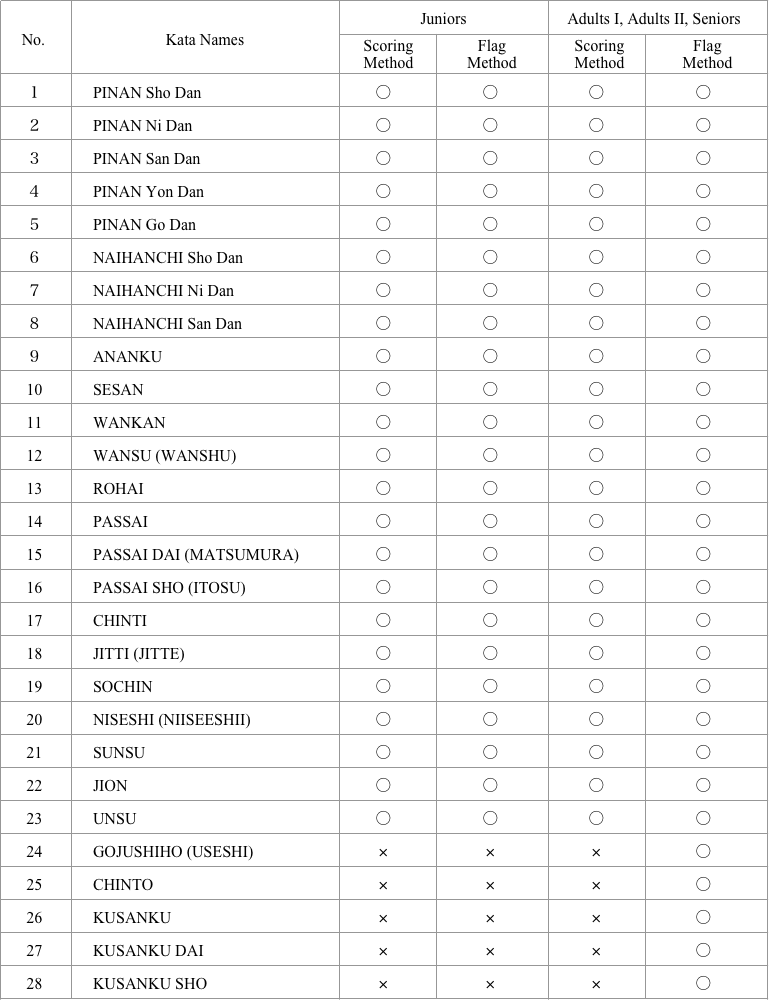
* “○” indicates a selectable Kata, and “×” indicates an unselectable Kata.
* The scoring system is adopted for the 1st preliminary rounds in Okinawa and mainland Japan/overseas.
* After the 2nd preliminary rounds in Okinawa and main tournament, the flag system is used.
APPENDIX 2 Naha-te kei
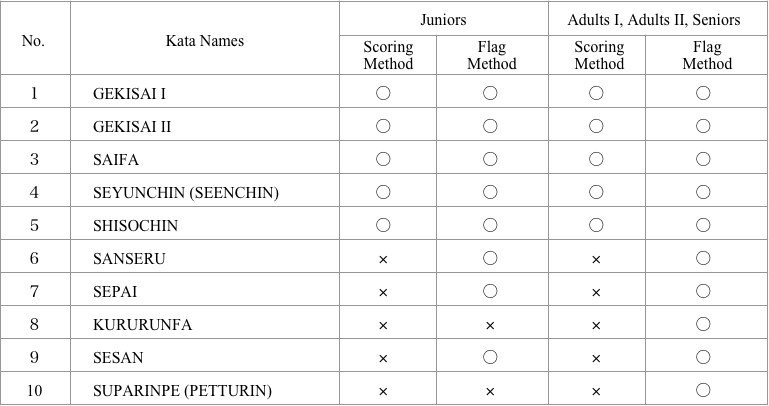
* “○“ indicates a selectable Kata, and “×” indicates an unselectable Kata.
* The scoring system is adopted for the 1st preliminary rounds in Okinawa and mainland Japan/overseas.
* After the 2nd preliminary rounds in Okinawa and main tournament, the flag system is used.
APPENDIX 3 Uechi-ryu kei
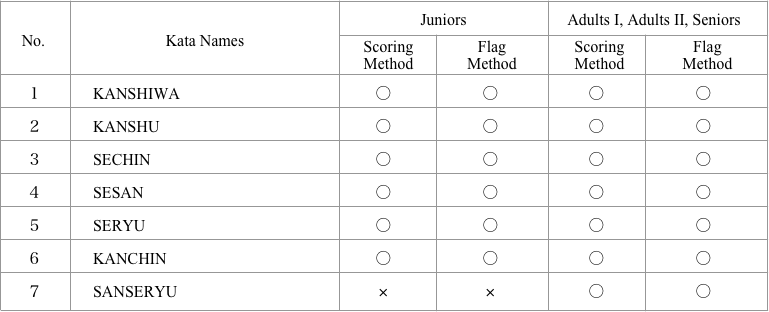
* “○“ indicates a selectable Kata, and “×” indicates an unselectable Kata.
* The scoring system is adopted for the 1st preliminary rounds in Okinawa and mainland Japan/overseas.
* After the 2nd preliminary rounds in Okinawa and main tournament, the flag system is used.
* Performing DAINI SESAN is not allowed in this tournament.
APPENDIX 4 Kobudo (Bo)
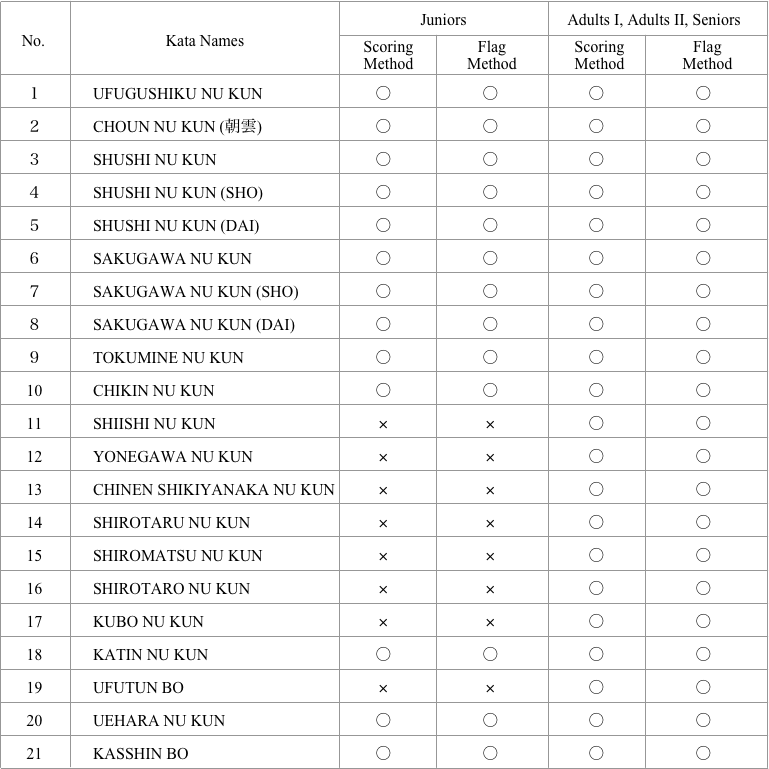
* “○“ indicates a selectable Kata, and “×” indicates an unselectable Kata.
* The scoring system is adopted for the 1st preliminary rounds in Okinawa and mainland Japan/overseas.
* After the 2nd preliminary rounds in Okinawa and main tournament, the flag system is used.
* Performing SESOKO NU KUN, SHUKUMINE NU KUN, CHIKIN SUNAKAKE NU KUN, CHIKIN
UFUKUN, RUFA NU KUN, HASSO NU KUN, CHOSHI NU KUN, URASHI NU KUN, CHIKIN BO,
CHATAN YARA NU KUN, and CHOUN NU KUN (趙雲) is not allowed in this tournament.
APPENDIX 5 Kobudo (Sai)
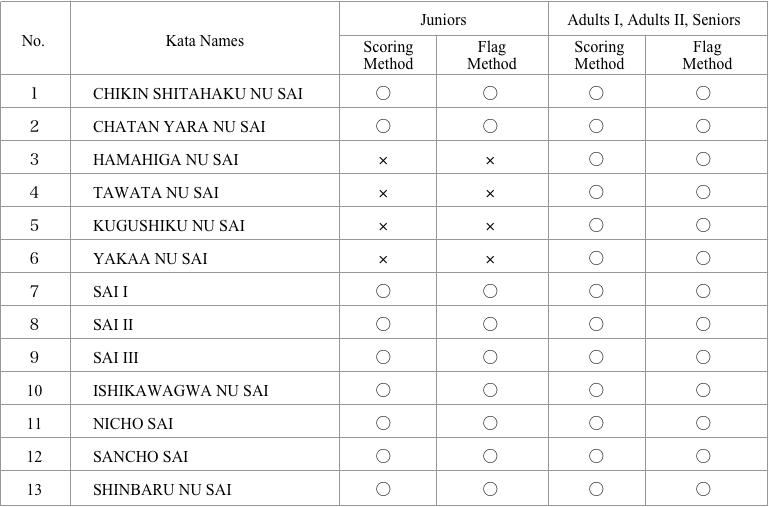
* “○“ indicates a selectable Kata, and “×” indicates an unselectable Kata.
* The scoring system is adopted for the 1st preliminary rounds in Okinawa and mainland Japan/overseas.
* After the 2nd preliminary rounds in Okinawa and main tournament, the flag system is used.
* Performing UFUCHIKU NU SAI, TOKUYAMA NU SAI and HANTAGAWA KORAGWA NU SAI is not allowed in this tournament.







